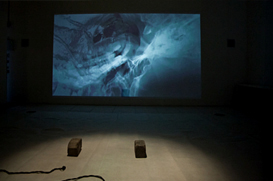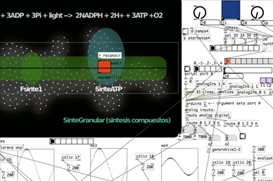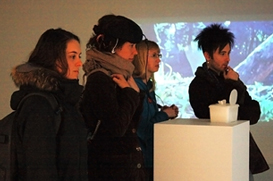4ª edición: 8 a 11 noviembre 2012 | English

![]() ART FUTURA
ART FUTURA
![]()
![]() JAPAN MEDIA ARTS
JAPAN MEDIA ARTS
FESTIVAL
![]()
![]() ARS ELECTRONICA
ARS ELECTRONICA
![]()
![]() MUNDOS DIGITALES
MUNDOS DIGITALES
![]()
![]() STREAMING MUSEUM
STREAMING MUSEUM
![]() NEW YORK
NEW YORK
![]()
![]() CINEWEST. SIDNEY
CINEWEST. SIDNEY
![]()
![]() CYBERBROTHERS
CYBERBROTHERS
![]() MOSCÚ. RUSIA
MOSCÚ. RUSIA
![]()
![]() DIGITAL LANDSCAPE
DIGITAL LANDSCAPE
![]() & Programa Curators
& Programa Curators
![]() - ARGENTINA
- ARGENTINA
![]() - UK
- UK
![]() - SAMVAAD II
- SAMVAAD II
![]() - BRASIL
- BRASIL
![]()
![]() MIDEN
MIDEN
![]()
![]() KIMUAK
KIMUAK
![]()
![]() GAME On!
GAME On!
![]()
![]() AVM
AVM
![]()
![]() PUNTO Y RAYA
PUNTO Y RAYA
![]()
![]() ATTRACTIONOPOSSITE
ATTRACTIONOPOSSITE
![]()
![]() MediaDOME
MediaDOME
![]()
![]() El MUR
El MUR
![]()
![]() FIVA
FIVA
![]() CIEVYC
CIEVYC
![]() UNIV. PALERMO
UNIV. PALERMO ![]()
![]() Made in CANARIAS
Made in CANARIAS
![]()
![]() IMAGEN DIGITAL
IMAGEN DIGITAL
![]() Videoarte
Videoarte
![]() Videodanza
Videodanza
![]() Cortometraje/Largo/3D
Cortometraje/Largo/3D
![]() Web Film
Web Film
![]() Animación
Animación
![]()
![]() Arte Ciencia Innovación
Arte Ciencia Innovación
![]() Artificial life
Artificial life
![]() Software art
Software art
![]() Trangenic art
Trangenic art
![]() Generative art
Generative art
![]() Bioart
Bioart
![]() Nanotecnología
Nanotecnología
![]() Geospatial storytelling
Geospatial storytelling
![]() Videojuegos
Videojuegos
![]() Robótica
Robótica
![]() Open Source
Open Source
![]() 2D & 3D Animación
2D & 3D Animación
![]() Net-art
Net-art
![]() Comunidades Digitales
Comunidades Digitales
![]() Redes Sociales
Redes Sociales
![]() Blog, videoblog
Blog, videoblog
![]() Desarrollo Apps
Desarrollo Apps
![]() Creación plataformas
Creación plataformas
![]() móviles
móviles
![]()
![]() patrocinadores
patrocinadores
![]() y colaboradores
y colaboradores
![]()
![]() programa
programa
![]()
![]() fotos sede
fotos sede
![]()
![]()
![]()
![]() evento 2009
evento 2009
![]()
![]() evento 2010
evento 2010
![]()
![]() evento 2011
evento 2011
![]()

- Artificial Life
- Software art
- Transgenic art
- Generative art
- Bioart
- Nanotecnología
- Geospatial storytelling
- Videojuegos
- Robótica
- Open Source
- 2D & 3D Animación
- Net-art
- Comunidades Digitales
- Redes sociales
- Blog, videoblog
- Desarrollo Apps
-
Creación plataformas móviles

Convocatoria Internacional 2012


Edinburgo UK
http://marcodonnarumma.com
Proyecto: Music for Flesh II
Music for Flesh II (MFII) is a seamless mediation between human biosonic potential and algorithmic composition.
The piece is based on the Xth Sense (XS) wearable technology, which was recently awarded the first prize in the Margaret Guthman Musical Instrument Competition as the "world's most innovative new musical instrument".
Please note, it is critical to view an audiovideo recording of this performance on-line, and with a sound system capable of playing back low frequency sounds, which represent the bulk of the biophysical music you will listen to.
By enabling a computer to sense and interact with the muscular sonic potential of human tissues, the work approaches the biological body as a means for computational artistry. I stand in a dark room, hit with two spotlights. When the visitors enter the room the performance begins. During my performance muscle movements and blood flow produce subcutaneous mechanical oscillations, which are nothing but low frequency sound waves. Two microphone sensors capture the sonic matter created by my limbs and send it to a computer. This develops an understanding of my kinetic behaviour by *listening* to the friction of my flesh.
Specific gesture, force levels and patterns are identified in real time by the computer; then, according to this information, it manipulates algorithmically the sound of my flesh and diffuses it through an a variable array of loudspeakers. The computer learns about and interact with the performance: for instance, strong and wide movements repeated for longer than 30 seconds prompt the computer to increase the sound loudness and density of the processed output; a repeated excitement of the left bicep causes a rich vibrato; an abrupt contraction of the right forearm moves the sound across the right side of the sonic field.
The neural and biological signals that drive the performer's actions become analogous expressive matter, for they emerge as a tangible haunting soundscape. The border between physical and virtual body is blurred and dissolved; by harvesting pure kinetic energy from corporeal sounds, incarnated gesture and concrete vibrations, the piece actualizes before the audience eyes a visceral and cognitively challenging territory.
Background and aesthetic: Interactive music performance relies on a flowing exchange between a human being and a computer. As Winkler [2] puts it, “nothing is more interactive than a good conversation”; both parties are engaged, they both share ideas and respond to each others inputs. A good conversation is usually open ended, yet bounded by an intangible frame of cultural contingencies and non-verbal stimuli, that are - more or less equally - shared by the participants. It is a delicate balance which can be achieved only by setting a “consistent context” that produces “a feeling of mutual understanding without being predictable”. On the other hand, for David Rokeby [1] the computer is “objective and disinterested”, and therefore the interaction (i.e. experience) “should be intimate”. Computers are not smart. Man creates their intelligence, Man forges them as interactive agents, and ultimately defines their degree of interaction with the real world. But what would happen if Man could breathe an understanding of human bodily expressiveness into the computer “tiny playing fields of integrated circuits”?
From this viewpoint new prospects of digital interaction and self-representation can be drawn. Body is no longer silent, and the embodied interaction which was so far kept mute, now acquires a new textural layer, a tangible and profound level of interpretation and representation which can be at the same time intimately experienced by the performer, and audibly and visually externalized in order to embrace the audience.
References: [1] Rokeby David. “Very Nervous System”. Available at: http://homepage.mac.com/davidrokeby/vns.html [Accessed July 25, 2011].
[2] Winkler Todd. Composing Interactive Music: Techniques and Ideas Using Max. The MIT Press, 2001.
tag: generative art


Edinburgh. UK
http://marcodonnarumma.com
Project: Hypo Chrysos
Action art for vexed body and biophysical media [Xth Sense Bionsensing Technology]
An HD live audiovisual recording of the performance can be viewed at http://vimeo.com/37921373.
This work can be viewed on-line at http://marcodonnarumma.com/works/hypo-chrysos/
This live audiovisual piece is freely inspired by the sixth Bolgia of Dante’s Inferno, located in one of the lowest of the circles of hell. Here the poet encounters the hypocrites walking along wearing gilded cloacks filled with lead; for Dante this was the punishment for the falsity hidden behind their behaviour, a malicious use of reason which is unique to human beings.
Pulling with my arms large ropes tied to concrete blocks, I struggle to walk along the stage. I can only walk in circle, I cannot give up until the action is completed.
The friction of human muscle tissues, and blood palpitations produce a biophysical signal in the form of an acoustic sound waves. The sounds of my muscle, heart and blood, normally inaudible to human ears, are captured and amplified through the Xth Sense wearable sensors (XS). A computer stores and accumulates those sonic pulses, computing an endlessly growing wall of sound that emerges from an octophonic array of loudspeakers. When the sonic vibrations of my inner body become tangible sound, they breach into the outer world, thus reaching and affecting the bodies of the audience. At the same time, the biosignal is used to create a swarm of virtual entities, lights and organic forms diffused by a video projector; a window into the subcutaneous flesh tissues of the vexed body. The raging clusters of sound and light emanated by my body give rise to an impactive and unstable force field of tension.
This work does not make use of computer vision, other motion tracking devices or proprietary hardware. All sonic and video material is generated in real time by the performer’s body using the XS, a free and open technology for musical performance and responsive milieux, developed by the author. See technical details below for further information.
This is the second work in a series of biomedia performances composed around the XS. You can learn more about the first piece of the series “Music for Flesh II” here.
tag: generative art


Barcelona. España
biosensing.tumblr.com// transnoise.tumblr.com
Proyecto: Photosynthetic concert
A través de los bioritmos de la naturaleza, podemos entender y tomar consciencia de cómo el entorno afecta a nuestras emociones. Estos bioritmos o datos interactúan con el ecosistema sonoro análogo/digital y a través del procesamiento con Pure Data (Pd)* traducen a sonido las emociones y afectos.
El proceso está siendo desarrollado bajo una percepción Ekológica; muestra una nueva abertura experimental; una intra-conexión de instrumentos de sensorización biológica e interfaces fisiológicas de donde emergen nuevas formas performativas.
Este ecosistema emerge de la fusión en vivo de las interacciones tecnológicas, las fuerzas y elementos naturales, el humano y las plantas.
En la naturaleza la fotosíntesis es un complejo proceso que genera energía química a partir de la luz del sol; el nuevo ecosistema traduce este complejo proceso a un ecosistema híbrido que traduce los procesos naturales a entornos sonoros artificiales generados por síntesis granular.
La síntesis sonora y la síntesis de elementos químicos emergen como punto de partida hacia una investigación más amplia. El proceso de “fotosíntesis artificial” es el último objetivo de la investigación, de ahí surge el deseo de obtener energía a partir de la catálisis del H2O o bien implementando dispositivos a través de bacterias fotosintéticas color púrpura “FOtoSINTETIKA” es un proceso de desarrollo de este sistema de escucha atenta de la naturaleza, las finalidades o líneas de desarrollo son amplias, las más evidentes: revelar lo no audible y configurar nuevas aperturas a través de la multiplicidad del NOISE.
tag: transgenic art / generative art / open source


CIA ERRE QUE ERRE DANZA
Barcelona. España
www.errequeerredanza.net
Proyecto: AVATAR
Avatar* tiene como a premisa interpretativa-conceptual, el hecho de representar y jugar en escena con nuestro propio avatar, que es la representación virtual de nosotros mismos.
Avatar* es un solo de danza, en el cual la interprete está en constante diàlogo con el software, responsable de los diferentes acontecimientos narrativos pre programados; ellos reaccionan en base a los desplazamientos, actitudes y gestos, por medio de la proyección y detección de las camaras, que envían las señales de posición al ordenador, encargado de procesar los datos y reenviarlas al espacio escénico en tiempo real.
tag: software art / dance


Ciudad de México. México
http://annigarzalau.com
Proyecto: Alteraciones Ambientales
Un paisaje cotidiano es mostrado en video, específicamente lo que podría verse desde la ventana de esta ciudad o cualquier otra. La humedad, temperatura, los colores en el escenario de acuerdo a la estación del año y el clima particular de cada lugar afectan, en menor o mayor grado, el estado anímico de las personas que lo habitan.
Alteraciones ambientales es una instalación que funciona de manera inversa a este proceso: el usuario puede, a partir de las ideas que el paisaje detone, la concentración y la atención prestada al video, modificar algunos aspectos del clima, la iluminación, el color y otros eventos que ocurren en la ciudad. De esta manera se crea un ciclo narrativo-ambiental a partir del estado del usuario, quien puede concentrarse en cambiar el escenario para adecuarlo a su humor.
El público puede acceder al video interactivo mediante un dispositivo lector de ondas cerebrales que se coloca en la cabeza. Cada vez que el usuario genera diferentes patrones eléctricos [si piensa o siente con mayor o menor intensidad] comienzan a ocurrir transiciones en el video, el cual tiene varias capas de eventos. La interpretación de datos como la meditación, la atención y ondas cerebrales específicas, sucede en tiempo real. Cabe mencionar que ya que cada cerebro genera patrones diferentes, la experiencia no será la misma para cada persona, pero siempre dependerá de qué tan atento y presente esté el usuario en ese momento.
Este trabajo está basado en algunas ideas sobre cómputo afectivo e interacción inteligente; el uso de tecnología en esta pieza invita al público a estar consciente de cómo el medio ambiente afecta su estado anímico y ofrece la posibilidad de modificar tanto el humor como la atmósfera a partir de un esfuerzo de la mente.
tag: software art


